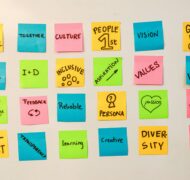Organizational Culture and Change
Book / Produced by partner of TOW
Culture is a dimension not only in the life of countries and ethnic groups but also in organizations. Every organization has a corporate “feeling” or environment that communicates to new and old members what is important and what is permitted. This is true of businesses, small groups, clubs, churches, nonprofit and parachurch organizations. The minute a person walks into the meeting room, the store, the office or the sanctuary, he or she picks up a nonverbal message that is more powerful than such mottoes as “The customer is number one”; “We exist to give extraordinary service”; “This is a friendly, family church.” Culture turns out to be profoundly influential in determining behavior, expressing values and enabling or preventing change.
Understanding Organizational Culture
People are sometimes frustrated, without understanding why, in trying to bring about change in an organization. Try to introduce women into an all-male kayaking club, and one encounters almost irresistible forces, none of which is rationally expressed or constitutionally codified. Further, some successful changes get reversed in a few months because they were not congruent with the culture of the organization; other changes are made easily for reasons that are not apparent unless one understands the invisible but all-pervasive impact of organizational environment. To change the culture itself is possibly the most substantial change that can be made. It has a multiple impact on everything else. A man in a museum looking at the colossal skeleton of a dinosaur that once triumphantly roamed the earth turned to the woman beside him and asked, “What happened? Why did they die out?” She said, “The climate changed.”
Motivation is primarily related to the culture. We draw motivation out of people in a healthy, life-giving organization. It is inspired, not compelled. Motivation is a result of a process in a group or system and is not just generated exclusively from within the individual. So motivation is only marginally increased by trying to get people motivated through incentives or threats. It needs to be considered culturally and systemically (see System).
The classic study on organizational culture is Edgar H. Schein’s Organizational Culture and Leadership. His central thesis is that much of what is mysterious about leadership becomes clearer “if we . . . link leadership specifically to creating and changing culture” (Schein, p. xi). According to Schein, culture includes each of the following but is deeper than any one of them: (1) the observed behavioral regularities in a group (for example, really good employees show up for work fifteen minutes early); (2) the dominant values of the group (for example, church attendance is the ultimate expression of spirituality in a local church); (3) the rules or “ropes” of the group (for example, the usual way to climb the hierarchy is to engage in leisure-time diversions with your superior); and (4) the feeling or climate that is conveyed (for example, while not prohibited, it is also not acceptable to bring forward negative comments in staff meetings). Schein says that culture concerns the underlying assumptions and beliefs that are shared by members of the organization and often operate unconsciously (p. 6).
The factors at work in an organizational culture can be pictured as three concentric circles. On the outside are the symbols, artifacts and visible signs of the culture, which are often incarnated in logos, mottoes, the appearance of a building, the way people dress and the titles by which people are addressed. The middle circle represents the values that underlie the more visible processes (see comments on faith, hope and love in Organizational Values). Values are simply what is cherished by the organization. Often these are unexpressed and unconscious. Sometimes the stated values are incongruent with the real values that inform the culture. For example, a business may claim that it cherishes strong family life for its employees but actually requires the sacrifice of family for the corporation. The smallest circle (and the least visible) represents the beliefs that inform the values. For example, a church may believe that women should be under men in a hierarchical arrangement. That belief will fundamentally affect the values and visible “artifacts” of the congregation. Beliefs are expressed in values, and values are expressed in symbols, cues and visible patterns of behavior.
Forming the Organizational Culture
In most organizations, culture is not formed overnight but through a long process. In the church, culture often originates with the founding pastor, who projects his or her own vision of what is right and valued and how people are to be treated. In a business it is often the founding president. In a college it is the founding principal. One element of the mysterious quality of leadership called charisma is how it enables a leader to embed his or her fundamental assumptions into the organization or group. This is done by whom the leader pays attention to, how the leader reacts to critical situations, whether the leader intentionally coaches other leaders, what criteria the leader uses for praising and rewarding others and on what basis the leader recruits or rejects other leaders.
Years before I understood anything about culture, I observed that each organization has something like a genetic code embedded at the time of conception that determines most of what it will become. The future of a person is in large measure the unraveling of his or her genetic code. In organizations the founding moment, person and principles are likewise exceedingly important. An organization that starts with certain assumptions about the nature of the community, its style of leadership and mission in society will find it very difficult, though not impossible, to change its culture later.
As the group evolves, members take on the founder’s assumptions, usually unconsciously. Some groups never allow their founder to die or leave, no matter how many successors have come and gone. Cultures tend to incarnate not only the strengths of founders but also their weaknesses. An organization would be helped if it could have a once-and-for-all funeral service for its founder! But whoever suggests this will often be resisted by the culture. In fact, the opposite approach is usually more fruitful: finding out everything we can about the contribution our predecessors have made and appreciating their gifts to the organization. One thing is certain: founders are influential. Schein’s work is extremely helpful in elaborating what happens at various stages in a group’s history (p. 191) and the importance of stories (about the “good old days”) in transmitting the culture of a group (p. 241).
Reflecting Theologically on Culture
Whether in a church or a business, the leader of an organization is in some sense the “minister of culture.” Another way of expressing this is to think of being an environmental engineer—a person who cultivates an organization’s culture so that the people in the organization will thrive. This task is implicit in the broad vocation of being human beings through which we are called to be culture and world makers (Genesis 1:26-28). God created the first culture in fashioning the sanctuary-garden for Adam and Eve, a garden with boundaries, structures, limits, challenges, work to do and pleasures to enjoy. The first human culture was a sabbath culture. There was a threefold harmony of God, humankind and creation. But once human beings sinned, they created cultures that would not bring rest to people or the earth.
The men and women of Babel (Genesis 11:1-11) wanted to create a monolithic, homogenous culture, and God judged that. Imagine what would have happened if that arrogant, self-serving and total-uniformity culture had dominated the human enterprise for thousands of years! In place of Babel God crafted a colorful, pluralistic culture at Pentecost through which those from many languages and peoples heard the wonderful works of God in their own languages (Acts 2:8). What God wants on earth is a rich social unity that thrives on diversity.
In passing, we may note that the Old Testament gives us a few hints of God’s grace in secular or pagan organizations. The culture of the Egyptian prison equipped Joseph to emerge as its leader (Genesis 39:20-23). As cupbearer to the pagan king Artaxerxes, Nehemiah was able to express his concern over the state of Jerusalem and be empowered to return to rebuild the walls (Neh. 2). God was at work in both. Daniel was skilled in the culture of the Persians and in that context was able to play a seminal role in the destiny of his people (Daniel 1-6).
In the New Testament Paul was continually engineering culture. His great lifelong vision was to create under God a church culture that embraced Jews and Gentiles as equal heirs, members and partners in Christ. His grasp of the gospel meant that Jews did not become Gentiles in Christ, nor did Gentiles become Jews. Rather both were incorporated into a “new humanity” (Ephes. 2:15 NRSV) that transcended these profound distinctions without obliterating the differences. The same was true of men and women, slave and free. Central to Paul’s ministry was a passion inspired by the gospel: God’s community on earth must be richly diverse but, at the same time, must treat all members as equal (2 Cor. 8:14). We can only speculate to what extent this carried over into his tentmaking business in which he was essentially self-employed, though often working side by side with that marvelous tentmaking couple Aquila and Priscilla.
The final cultural image in the Bible is the most empowering. In the new heaven and the new earth (Rev. 21-22) every person’s contribution is evoked in the fulfillment of the priesthood of all believers (Rev. 1:6). Every nation, tongue and tribe is preserved rather than merged into one homogenous uniformity. Our future in Christ is to become not angels but full human beings in our resurrection bodies as we work and play in this fulfilled sabbath—the threefold harmony of God, humankind and creation. Even the kings of the earth bring their wealth and gifts into the holy city (Rev. 21:24). All human creativity finds perfect fulfillment, and every tear of frustration is wiped away (Rev. 7:17). What a response this should evoke! Keeping heaven in view turns out to be the most practical thing on earth.
Making Organizational Change
We are not in heaven yet. Indeed, all human organizations are approximations. Human organizations have fallen and have been captivated by the principalities and powers. These powers have been unmasked and disarmed by Christ (Col. 2:15), but the best we can hope for in this life is substantial, not complete, redemption. Gaining that—and it is as part of our public discipleship—involves organizational change. Organizational change involves culture. And changing the culture is difficult. How difficult change is!
A cultural approach to change. Changing the artifacts—to use Schein’s phrase—might involve moving the Sunday service to the church hall, where the chairs can be arranged in circles to increase participation, or having a staff meeting every Monday to improve communication. But unless the fundamental assumptions of the organization are understood, cultivated and gradually changed, such equipping initiatives may be as effective as rearranging the deck chairs on the Titanic when the ship is going down. When the leader and the culture collide, the culture will probably win!
Schein’s research shows, however, that culture-change mechanisms are at work in every stage of a group’s history—birth, midlife and maturity (which he calls maturity and/or stagnation, decline and/or rebirth; p. 270). He also shows that change becomes increasingly more difficult as a group becomes more established. While all change is motivated and does not happen randomly, “many changes do not go in the direction that the motivated persons wanted them to go” (Schein, pp. 300-301) because they were unaware of other forces in the culture that were simultaneously acting. So being the leader of this process is complex indeed.
Several strategies are useful here. First, understand the culture before you try to change anything. Give the culture its due. It influences everything. Second, recognize that the culture cannot be manipulated. While you can manage and control many parts of the environment of an organization (the president keeps her office door open all the time), the culture itself with its taken-for-granted underlying assumptions cannot be manipulated. Third, good leadership articulates and reinforces the culture, especially those parts consistent with the vision of the organization. If this is not done, people are unlikely to accept any serious change. During a time of changing culture, leaders have to bear some of the pain and anxiety felt in the group at the same time that they seek to make the members feel secure. Fourth, sometimes direct change in a culture can be promoted by introducing new people in leadership, by promoting maverick individuals from within and, more especially, people from outside who hold slightly different assumptions. The appointment of a new pastor, a new assistant, a new board chairperson, a new president is an opportunity for cultural change. Finally, change takes time (Schein, pp. 297-327).
A systemic approach to change. A systems approach treats an organization as a whole that is more than the sum of the parts, in which each member and each subsystem is influenced by and influences the others. It can be easily pictured as a mobile: movement in one element requires adjustment in all the others. Edwin Friedman, a family systems therapist, has some additional insights on how a leader can bring change to a system. He uses the concept of homeostasis, that marvelous capacity of human bodies and social systems to regain their balance after a trauma. Every system has a natural tendency to maintain the status quo (homeostasis), just as a keel keeps the sailboat upright. The system does this when new response patterns are required through a threat, tragedy or positive change. Thus the system returns to the tried and tested rather than shifts to operate on a revised and improved basis (morphogenesis). A negative biblical example of homeostasis is the return of converted Jews in the first few years to a less-than-full expression of Christian unity with Gentile believers, a hypocrisy that Paul fervently challenged (Galatians 2:11-21). A positive example of morphogenesis is the extraordinary resolution of the council of Jerusalem (Acts 15:1-29) in which the church changed the terms upon which Jews and Gentiles could have fellowship together.
To bring about systemic change, leaders must first join the system, becoming an integral part of the whole and negotiating their place within it. The director, pastor or president must lead the way in this. In fact this involves many stages of negotiation as the leader finds his or her place in the organization (Pattison). Then the leader might take an initiative that has a ripple effect throughout the system. Usually a problem will surface without provocation. But if a problem does not surface, something as inconsequential as changing the location of the water cooler or removing it altogether will do. How he or she responds to the ripple is crucial because the response of the system will be a reflection of all the systemic factors that make it stable, including the multigenerational influences. The provoked or unprovoked crisis is an opportunity to explain what is going on and to appeal, as Barnabas, Paul and Peter did in the Jerusalem council (Acts 15:1-35), to systemic values that can be expressed in a more constructive way. The Chinese word for crisis is composed of two characters, one of which means “danger” and the other “opportunity.” The systemic leader welcomes the opportunity of every crisis and sometimes will provoke one.
Using family systems theory, Friedman says we bring greatest change in a system by concentrating not on the dissenting or sick member but on the person or persons in the group who have the greatest capacity to bring change (p. 22). The equipping leader must always remember that the only person open to definite and immediate change is herself or himself! A systems view encourages us to see that changing ourselves can make a difference to the those with whom we are interdependent.
In the context of counseling families, Virginia Satir makes a remarkable statement about systems leadership that applies to all kinds of organizations. She says, “I consider myself the leader of the process in the interview but not the leader of the people.” This, she continues, “is based on the fact that I am the one who knows what the process I am trying to produce is all about. I want to help people to become their own designers of their own choice-making” (Satir, pp. 251-52).
So organizational leadership is not simply leading individual people in an organization. Leaders must work with the whole—culture and systems included. Process leadership asks questions, clarifies goals, orients people to their mission, maintains and explains the culture and helps people and subsystems take responsibility for their own systemic life. In the end leaders are charged with the awesome task of creating an environment in which people change themselves.
» See also: Equipping
» See also: Leadership
» See also: Management
» See also: Power
» See also: Organization
» See also: Organizational Values
» See also: Structure
References and Resources
P. Collins and R. P. Stevens, The Equipping Pastor: A Systems Approach to Empowering the People of God (Washington, D.C.: Alban Institute, 1993; portions quoted with permission); M. DePree, Leadership Is an Art (New York: Doubleday, 1992); E. H. Friedman, Generation to Generation: Family Process in Church and Synagogue (New York: Guilford, 1985); R. K. Greenleaf, Servant Leadership: A Journey into the Nature of Legitimate Power and Greatness (New York: Paulist, 1977); M. E. Pattison, Pastor and People—A Systems Approach (Philadelphia: Fortress, 1977); J. Renesch, ed., New Traditions in Business (San Francisco: Berrett-Koehler, 1992); V. Satir, Conjoint Family Therapy, rev. ed. (Palo Alto, Calif.: Science and Behavior, 1983); E. H. Schein, Organizational Culture and Leadership: A Dynamic View (San Francisco: Jossey-Bass, 1991).
—R. Paul Stevens





